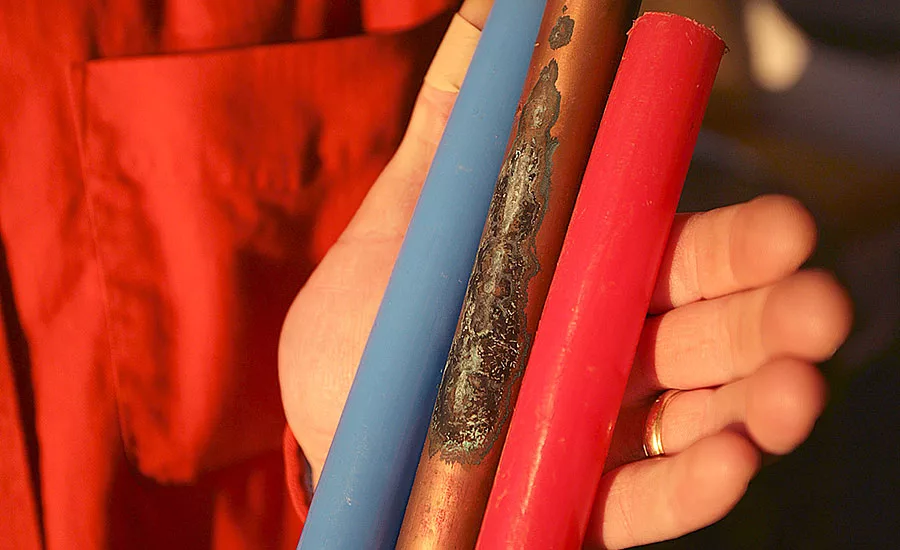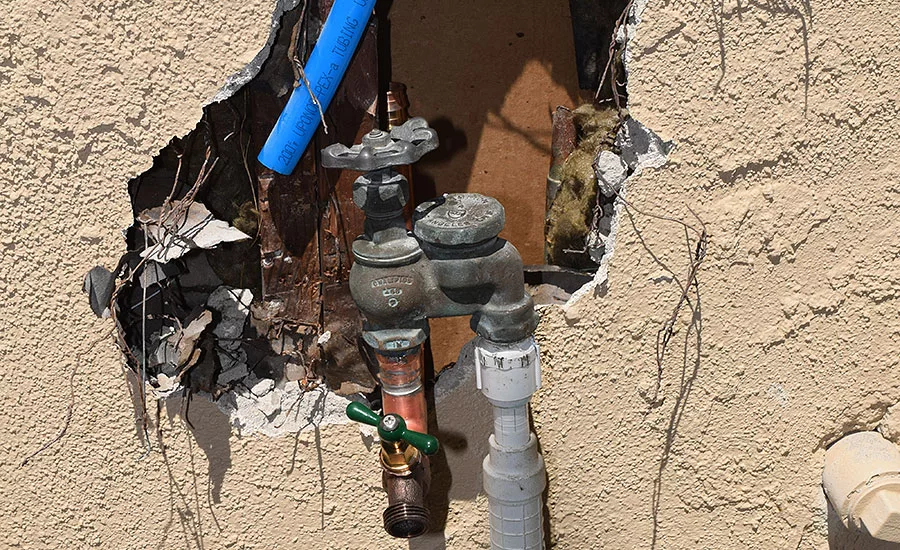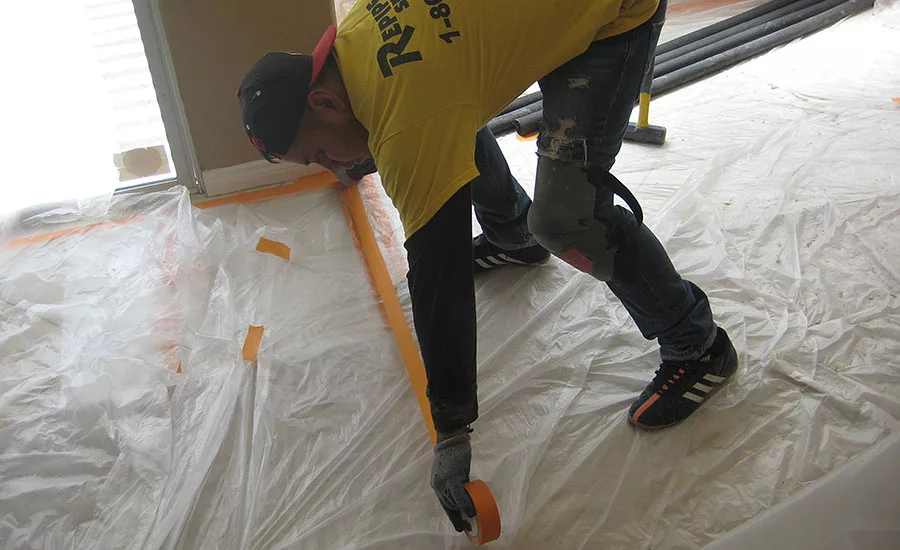Copper and PEX retrofits in Southern California Neighborhood
Profitable Do-Overs

Repiping is a quick way to eliminate pinhole leaks— a couple of days and it's like the whole thing never even happened. Repipe Specialists photo.


Even something as innocuous as a hose bibb or an irrigation system doesn't escape the attention of the repipers. RJ photo.

The whole house is taped- and tarped off to make cleanup when the job's done easier and quicker. Repipe Specialists photo.
Weren’t the early 2000s a great time to be buying real estate? Things were getting expensive in some communities, but no matter – a little creative financing and you could move into a McMansion that wasn’t there yesterday. Then, pulling out the fast-collecting equity bestowed on you by an accelerating market, you could trick out your 10,000 square foot abomination’s circular driveway with ski boats, bass boats, shiny new 4x4 pickups and, perhaps, a brace of BMWs.
That real estate market came to an end, however, squelching the ambitions of the “home-as-ATM” crowd and driving them back into the shadows. But the boom times have left relics – neighborhoods all over the country that sprang up during the rush are now getting ready to celebrate their 20th anniversaries. The problem is that sometimes building things quickly can lead to corners being cut and shortcuts being taken that can come back to haunt homeowners and developers years later.
A different boom
Take, for example, Ladera Ranch. It’s an unincorporated neighborhood located in the former chaparral foothills to the southeast of the city of Mission Viejo, Calif. It’s a master-planned, family-friendly community made up of single-family homes, condos, apartments and senior living communities. It broke ground in 1999 and, in 2010, the U.S. Census reported the community had a population in excess of 22,000.
Today it is a fertile area for plumbers in the repiping business. RJ’s purpose isn’t to report on legal matters but, according to Jeff Butler, pretty much every home in the 4,000-acre development has either been, or will soon be, repiped to eliminate leaks. Butler is the owner and president of Repipe Specialists, Inc., of Glendale, Calif., and he says the company is, “the largest single-family home repiping company in the country.” Indeed, the company has locations in California, Texas, Washington, Texas and as far eastward as Chicago. And, with jobs on tap like repiping the whole community of Ladera Ranch, the company doesn’t look to be on track to lose any girth any time soon.
“This is common not just in Ladera Ranch but in a lot of areas of Orange County where they built new homes over the last, basically, 10- to 20 years. There’s a copper piping that is developing pinhole leaks and I think there’s some dispute as to what is causing it,” Butler says. “You know, kind of a common belief is that it’s the chloramines that are being added to the water to assist with the potability but it’s not helping. It’s much more aggressive on the pipes and it’s causing the pinhole leaks. And so we have to go in and repipe them all. We see there’s some in the Bay Area, but I think primarily we’re seeing it in Orange County because you have a lot of houses that were built over the past 10- to 20 years and so they were built with a cheaper grade of copper. Then combine that with the water issue and that makes for a bad combination.”
Drought ramifications
OK, so this story is supposed to be about “drought-busting” plumbing. Replacing copper plumbing with pinhole leaks with new PEX or higher-quality copper in one neighborhood can’t possibly have that much effect on a regional drought. Or can it? Well, we could be talking tens of thousands of gallons annually, just from one residence.
“I happened to see a customer’s water bill. We were looking at the water bill totry to help them to get a credit with the city or whatever, and they had a leak under the house. You could clearly see on their water bill where it spiked from using, maybe, 40,000 to 50,000 gallons a month and they jump in top into well over hundreds of thousands of gallons a month. And it was over a course of, I think, five or six months. So they had lost hundreds of thousands of gallons of water from one leak.”
Perhaps there are hundreds of thousands of gallons wasted in a single home annually. Multiply that by thousands of homes in a development and thousands of developments of a certain age across the region and the numbers become staggering fast. The math is pretty obvious, but what isn’t obvious is the potentially tens of thousands of dollars in damage to a home an undetected under slab leak can cause in structural damage by eroding the soil under the slab, possibly creating a void space under the structure. Foundation cracking is common in a scenario like that.
“Sometimes you never know about it,” he said. “If it’s underneath the slab and it has some drainage that works decently well, it can leak for a long time and you’ll never know about it. More recently, we’re seeing [leaks] all over the place, both above and below the slab. So obviously, the ones above the slab, you’re going to catch fairly quickly, but the ones below the slab, of course, those can go on for a long time.”
The task at hand
Butler doesn’t know the exact number of homes in Ladera Ranch needing a repipe, but he guesses the number could be approaching 10,000. And, with the development-wide issue to contend with, he says he is generally called in to do his repiping stuff by homeowners rather than officials.
“We’re not called in by the city, but most of time we’re called in by an individual homeowner. There was a recent settlement between [litigating parties]. And so, in that case, it’s a settlement that’s run by an administrator and that administrator then hires a company or two or three or however many to actually do the repiping. In that case, the settlement is paying us and we’ve done those types of projects as well. We’re actually currently doing one of them.”
There’s more than one company doing possibly 10,000 or more residences? That’s a ton of work so you figure Repipe Specialists, Inc., may be on track to do 40 or 50 homes, right?
“Well, just in Ladera Ranch, in just the one lawsuit, we’re doing 150-plus,” he says. “We do copper repiping — we’ve done it for a long time but I would say most people, or the vast majority, use PEX now. The reason being you can eliminate the metal in your system because metal is what those chloramines are attacking. And if you can get metal out of the system, then you’re in good shape.”
Of course, when you’re doing wholesale quantities of repiping jobs, you want to spend as little time on the jobsite as possible before moving along. PEX, with its flexibility, goes in fast and with its fewer required connections there are fewer potential leak sites in a system.
“You start to open up the walls basically in the same way and so forth and you have to run the pipe,” Butler says. “But it is a little bit faster to run PEX, obviously, because you don’t have to solder but you still have to connect the pipes essentially in the same places that you would copper.” But it is a little bit easier and a little bit faster. And that can be deceptively quick.
“We repipe pretty much any sized house in a day. And so whether it’s copper or PEX or whatever, we’ll knock it out in a day,” he says. “Basically, what we might do is if we were going to have, say, six guys do a repipe on a PEX house, we might put seven or eight guys on there to repipe on a copper house. The permit and all that stuff is pretty much the same. We have the same amount of patching whether it’s copper or PEX.”
Other benefits
Cutting right to the chase, there’s more benefit to a repipe than eliminating pinhole leaks. That is, if the old piping was blocked with scale or corrosion, the homeowner may see a pleasant increase in water pressure at faucets, showerheads and hose bibbs. Of course, in areas like Ladera Ranch, there isn’t very much corrosion or scale in the pipes – they’re too new.
“If you’re replacing copper it doesn’t really affect it that much, but a lot of the repipes that we do, which we haven’t really talked about, are galvanized pipes,” he says. “They rust and corrode and when you put new PEX or copper pipes in there, yeah, you see a dramatic difference in the water volume.”
Repiping a home carries with it a relatively hefty price tag — in the $4,000 to $9,000 range, Butler says, depending on the house. Possibly because of this a misconception exists that a repipe is a major disruption to the life around a house and involves tying up excessive resources from the contractor. Well, there’s a day of prep, a day of repiping and a day of inspections, drywall repair and cleanup. Your customers probably won’t want to be around while it’s happening, but it’s really not all that drastic.
“One of the most common things that people say to us when we repipe is, ‘If I would have known it was this easy to do, I would have done it five years ago’. Yeah, because they have the idea that it’s this big, complicated process which it is, but the reality of it is we do as many as a hundred of these every week. We know how to get in and get out and make the customer’s life easy. I mean, they literally could leave for three days, come back and their entire house is put back together. They hardly would know we were there and they’d have all new plumbing done in their home.”
"This article was originally posted on ww.reevesjournal.com."
Looking for a reprint of this article?
From high-res PDFs to custom plaques, order your copy today!





